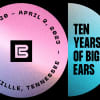Up until recently, most of Grouper’s music was largely unavailable on vinyl. Liz Harris would press limited runs, and they'd disappear almost immediately. The MP3s are easy to come by, but there's a religious quality to her music that lends itself to the physicality of vinyl. Queueing up one of her albums in iTunes while I'm on Instant Messenger and responding to emails is something I do, but I try not to make a habit of it. I can't think of another context in which I ascribe arbitrary rules to how I listen to someone's music, but with Harris—it's almost like she's playing in the background as a way of making you pay attention. You can hear as many of her lyrics as you want to hear, or as little. Listening to Grouper is about treating a sketch as a finished product, letting your mind fill in the blanks that Harris purposefully leaves. It's a selfish form of listening. Harris doesn't know my life and I don't really know hers, but for the duration of any of her albums, it feels like we're sharing something deeply personal.
Kranky recently released The Man Who Died in His Boat, an album that shares plenty of sonic similarities to Harris' "accessible" 2008 LP, Dragging a Dead Deer Up a Hill. Both records feature more conventional songs, intelligible lyrics and moments of broad emotional honesty. Hearing Harris' voice rise above the murk of her guitar to sing I'd rather be sleeping is one of the most emotionally devastating musical moments I've encountered.
The Man Who Died in His Boat was recorded around the same time Harris was working on Dragging a Dead Deer, and it works as a perfect companion. Already, the two albums are inseparable for me. Listening to one is great, and listening to both gets us closer to the full picture—probably as close as we'll ever get. Harris does not seem to be in the business of making things easy for us.
Last fall, Harris performed in a church in Portland, Oregon with Jesy Fortino, who records as Tiny Vipers. They played songs from Foreign Body, their collaborative album as Mirrorring. Fortino's work as Tiny Vipers occupies the same melancholy, dream-like space as Harris' music, but it's more fleshed out. On Foreign Body, she works as an anchor, providing shape, form and weight to Harris' more overtly ethereal moments. After the show, I did something I haven't done in years. I rushed to the merch table to try to snatch up any Grouper records I didn't have on vinyl. I got what I didn't have, and paid for my records. I was, at the time, wearing a Sade hat. Harris saw it and immediately mentioned that she loved the texture of Sade's music. This is a pretty broad statement, but I immediately agreed. Sade has developed an easy, emotionally pure sound that I associate with humid thickness more than most music that actually aims for humid thickness.
Listening to The Man Who Died in His Boat and Dragging A Dead Deer Up a Hill (which Kranky thankfully reissued on vinyl) back to back, that brief mention of texture came back to me. It's a word I throw around in this column a lot. For ambient and drone music, I'd go as far as saying it's one of the most important elements. It shapes the mood of a song. When it's done well, it can change your outlook.
When Harris is at her most compelling, she's writing songs that break from the hazy, distant textures she's created. It's an effect similar to holding your head halfway underwater, so your ears are below but your eyes are above, and slowly rising outward until everything sounds clear.
When I was about ten years old, I'd spend all summer swimming in Lake Washington. There was one particular beach that had a floating dock out in the lake. I remember standing on that dock, gently rocking back and forth, looking at something white and fluttering at the bottom of the lake. It was pretty far down, but for whatever reason it was clear enough to see that day. I wanted to get a better look, so I dove to get it. It was too far down, and I just barely got to it. It was a five dollar bill pegged by a rock. I grabbed the money, which hadn't yet disintegrated, and swam to the surface. As I got closer, I started to realize that I really didn't have enough air. I kicked frantically and burst above the water, gasping, almost exactly like it happens in the movies. I remember those last few seconds before I surfaced as a rush of sound and color. The muffled comfort of being underwater immediately gave way to shrieks and sharp splashes. I clambered up on the dock to lay the five dollar bill out to dry and felt weird about how loud everything sounded.


